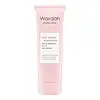Garnier Sakura Glow Ceramide Water Gel Versus Wardah Hydra Rose NMF Amino + Pentavitin Barrier Replenish Gel Cleanser
What's inside
What's inside
 Key Ingredients
Key Ingredients

 Benefits
Benefits

 Concerns
Concerns

 Ingredients Side-by-side
Ingredients Side-by-side

Water
Skin ConditioningGlycerin
HumectantNiacinamide
SmoothingAlcohol Denat.
AntimicrobialDimethicone
EmollientIsononyl Isononanoate
EmollientCeramide NP
Skin ConditioningCarbomer
Emulsion StabilisingDimethiconol
EmollientParfum
MaskingSodium Hydroxide
BufferingSalicylic Acid
MaskingSodium Hyaluronate
HumectantPhenoxyethanol
PreservativePrunus Lannesiana Flower Extract
Skin ConditioningTocopheryl Acetate
AntioxidantLimonene
PerfumingCaprylyl Glycol
EmollientCapryloyl Salicylic Acid
ExfoliatingTetrasodium Glutamate Diacetate
Citronellol
PerfumingBiosaccharide Gum-1
HumectantXanthan Gum
EmulsifyingMenthoxypropanediol
MaskingPseudoalteromonas Ferment Extract
HumectantButylene Glycol
HumectantHexyl Cinnamal
PerfumingWater, Glycerin, Niacinamide, Alcohol Denat., Dimethicone, Isononyl Isononanoate, Ceramide NP, Carbomer, Dimethiconol, Parfum, Sodium Hydroxide, Salicylic Acid, Sodium Hyaluronate, Phenoxyethanol, Prunus Lannesiana Flower Extract, Tocopheryl Acetate, Limonene, Caprylyl Glycol, Capryloyl Salicylic Acid, Tetrasodium Glutamate Diacetate, Citronellol, Biosaccharide Gum-1, Xanthan Gum, Menthoxypropanediol, Pseudoalteromonas Ferment Extract, Butylene Glycol, Hexyl Cinnamal
Water
Skin ConditioningGlycerin
HumectantSodium Laureth Sulfate
CleansingCocamidopropyl Betaine
CleansingPropylene Glycol
HumectantAcrylates Copolymer
Sodium PCA
HumectantDecyl Glucoside
CleansingPhenoxyethanol
PreservativeSodium Lauroyl Sarcosinate
CleansingSodium Chloride
MaskingCitric Acid
BufferingSodium Hydroxide
BufferingChlorphenesin
AntimicrobialGlyceryl Polyacrylate
Brassica Campestris Seed Oil
Skin ConditioningDisodium EDTA
Saccharide Isomerate
HumectantParfum
MaskingRose Extract
Skin ConditioningSodium Citrate
BufferingTocopherol
AntioxidantWater, Glycerin, Sodium Laureth Sulfate, Cocamidopropyl Betaine, Propylene Glycol, Acrylates Copolymer, Sodium PCA, Decyl Glucoside, Phenoxyethanol, Sodium Lauroyl Sarcosinate, Sodium Chloride, Citric Acid, Sodium Hydroxide, Chlorphenesin, Glyceryl Polyacrylate, Brassica Campestris Seed Oil, Disodium EDTA, Saccharide Isomerate, Parfum, Rose Extract, Sodium Citrate, Tocopherol
 Reviews
Reviews

Ingredients Explained
These ingredients are found in both products.
Ingredients higher up in an ingredient list are typically present in a larger amount.
Glycerin is already naturally found in your skin. It helps moisturize and protect your skin.
A study from 2016 found glycerin to be more effective as a humectant than AHAs and hyaluronic acid.
As a humectant, it helps the skin stay hydrated by pulling moisture to your skin. The low molecular weight of glycerin allows it to pull moisture into the deeper layers of your skin.
Hydrated skin improves your skin barrier; Your skin barrier helps protect against irritants and bacteria.
Glycerin has also been found to have antimicrobial and antiviral properties. Due to these properties, glycerin is often used in wound and burn treatments.
In cosmetics, glycerin is usually derived from plants such as soybean or palm. However, it can also be sourced from animals, such as tallow or animal fat.
This ingredient is organic, colorless, odorless, and non-toxic.
Glycerin is the name for this ingredient in American English. British English uses Glycerol/Glycerine.
Learn more about GlycerinParfum is a catch-all term for an ingredient or more that is used to give a scent to products.
Also called "fragrance", this ingredient can be a blend of hundreds of chemicals or plant oils. This means every product with "fragrance" or "parfum" in the ingredients list is a different mixture.
For instance, Habanolide is a proprietary trade name for a specific aroma chemical. When used as a fragrance ingredient in cosmetics, most aroma chemicals fall under the broad labeling category of “FRAGRANCE” or “PARFUM” according to EU and US regulations.
The term 'parfum' or 'fragrance' is not regulated in many countries. In many cases, it is up to the brand to define this term.
For instance, many brands choose to label themselves as "fragrance-free" because they are not using synthetic fragrances. However, their products may still contain ingredients such as essential oils that are considered a fragrance by INCI standards.
One example is Calendula flower extract. Calendula is an essential oil that still imparts a scent or 'fragrance'.
Depending on the blend, the ingredients in the mixture can cause allergies and sensitivities on the skin. Some ingredients that are known EU allergens include linalool and citronellol.
Parfum can also be used to mask or cover an unpleasant scent.
The bottom line is: not all fragrances/parfum/ingredients are created equally. If you are worried about fragrances, we recommend taking a closer look at an ingredient. And of course, we always recommend speaking with a professional.
Learn more about ParfumPhenoxyethanol is a preservative that has germicide, antimicrobial, and aromatic properties. Studies show that phenoxyethanol can prevent microbial growth. By itself, it has a scent that is similar to that of a rose.
It's often used in formulations along with Caprylyl Glycol to preserve the shelf life of products.
Sodium Hydroxide is also known as lye or caustic soda. It is used to adjust the pH of products; many ingredients require a specific pH to be effective.
In small amounts, sodium hydroxide is considered safe to use. However, large amounts may cause chemical burns due to its high alkaline.
Your skin has a natural pH and acid mantle. This acid mantle helps prevent harmful bacteria from breaking through. The acid mantle also helps keep your skin hydrated.
"Alkaline" refers to a high pH level. A low pH level would be considered acidic.
Learn more about Sodium HydroxideWater. It's the most common cosmetic ingredient of all. You'll usually see it at the top of ingredient lists, meaning that it makes up the largest part of the product.
So why is it so popular? Water most often acts as a solvent - this means that it helps dissolve other ingredients into the formulation.
You'll also recognize water as that liquid we all need to stay alive. If you see this, drink a glass of water. Stay hydrated!
Learn more about Water